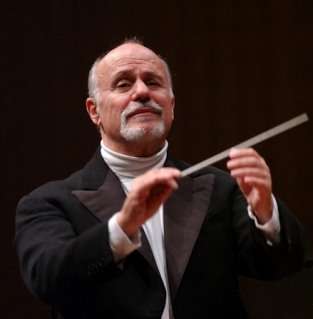|
Back
Beethoven In New Clothes New York
Avery Fisher Hall, Lincoln Center
03/15/2012 - & March 16, 17, 20, 2012
Ludwig van Beethoven: Symphony No. 1 in C Major, Opus 21 – Symphony No. 3 in E-flat Major “Sinfonia Eroica”, Opus 55
Karl Amadeus Hartmann: Concerto Funebre for Solo Violin and String Orchestra
Gil Shaham (Violin)
New York Philharmonic Orchestra, David Zinman (Conductor)

D. Zinman (© Courtesy of the Artist)
Just before starting Beethoven’s Fifth Symphony, a conductor put down his baton and faced the audience.
“Okay,” he grinned, “Stop me if you’ve heard this one!”
Bronx-born conductor David Zinman, a household name in Central Europe who performs too rarely here, wouldn’t take that old vaudeville jape lightly. His well-publicized aim this week has been to play Beethoven not necessarily in their “authentic” guise (the low standards of the early 19th Century and larger concert halls today would preclude that). But after new scholarship, and judiciously parsing post-Beethoven editorialization, Zinman aims “to bring the Beethoven symphonies to life in a vital and vivid way.”
With the New York Philharmonic–truncated for the First Symphony, at full size for the “Eroica”– he certainly gave his audience a strikingly different pair of symphonies. Like all musicians these days playing older works, the pace is quicker, the tempos almost jump out, and one gets the obviously erroneous feeling that the artists are anxious to go out and have a sandwich.
But that wasn’t what struck this listener. Not the pacing as much as the lack of changes as the music went on. In my definitely not “urtext” Beethoven, the score is filled with ritards and accelerandos. We are used to hearing Beethoven like a nice car trip, enjoying the scenery as it flips by, but slowing down at the curves, whipping up the gas for needed urgency, and varying our visions.
But the Beethoven First, starting with an introduction that was closer to Allegro than Adagio molto, was played as a single jolly tapestry, never dwelling on measures or preparing us for a new emotion.
In doing this, Mr. Zinman allowed us to be surprised (happily surprised) as the cross-rhythms (two/four oom-pahs at the bottom of the scale, triplets at the top), and a machine which pumped out the music.
It was not like Haydn, but meta-Haydn, playing according to the rules, but with newer material–material so interesting that it must have bewildered those critics of 1800.
In the Eroica, Mr. Zinman again plunged ahead, perhaps too mechanically before getting to what we now consider the “meat” of the symphony, the funeral march. But the way he conducted, that section , while tragic enough, was somewhat distant, as if Mr. Zinman was saying, “Yes, we all know how good this was. But listen to this terrific scherzo. Take an earful of these Philharmonic horns whacking away.”
In fact, I personally felt the Third Symphony was more notable for its finale, where Beethoven showed his contrapuntal muscle. Instead of making this a picture of miraculous variations, Mr. Zinman showed Beethoven having fun putting together the most disparate elements, proving that Beethoven never saw Bach as a curiosity but an ardent teacher.
I’m uncertain if Mr. Zinman’s performance would be in my record libraries (I’m still a sucker for that old-fashioned Furtwängler, Toscanini and Klemperer Beethoven), but he did achieve his goal of making Beethoven new and even vibrant.
Before the Beethoven funeral march, Gil Shaham played a work I’d never heard before (and was a Phil premiere), Karl Amadeus Hartmann’s Concerto Funebre. Hartmann was one of those unhappy composers who never got into the swing of things. His early years, he shunned the proletariat music of Eisler and Weill, never took much interest in the atonalism, and–worst of all–he never left Nazi Germany, so kept on writing. (Though he never wrote anything simple enough for the Nazis to enjoy.)
After the war, he shunned Boulez and Stockhausen, and kept on writing in his competent, not terribly interesting style.
Gil Shaham can of course make anything interesting, and he performed with his ravishing tone, beautiful phrasing and total dedication. Still, by the time he came to the last movement chorale, I was very happy to hear a familiar melody, this from the “eternal memory” of Shostakovich’s Eleventh Symphony
Unlike the Hartmann, the Russian revolutionary symphony never hid its tragedy or emotions. Nice to hear the Hartmann, I guess, but like the original vaudeville jest, I would be happy to stop him if he played it again.
Harry Rolnick
|